

Welcome to the practice tests for the Police Officer Exam. Remember, since this is an eBook, directions will look similar to those you will see on test day, but you will need to record all of your answers separately.
Good luck!


This exam is the first of three practice examinations you will be taking. This examination is an original examination prepared to conform with the actual police officer examination as closely as possible. When you have finished taking all three examinations, you will see that you are prepared to take most major police officer examinations, including those for Transit and Housing Police Officer.
Be sure to take Practice Examination One in one sitting. You will then become accustomed to concentrating for a period of 4 hours, which is the length of time allowed for the examination. Be sure to review the test-taking strategy outlined in the Introduction before taking this practice examination.
BEFORE YOU TAKE THE EXAMINATION
When you begin this examination, look first at the material marked “Memory Material,” which begins on the following page. After reading the material for the time specified, continue to the “Test Material” and do not look back at the material marked “Memory Material.” Then continue with the rest of the test.
Remember to read each question and related material carefully before choosing your answers. Select the choice you believe to be the most correct, and mark your answer on the Answer Sheet provided at the beginning of this chapter. The Answer Key, Diagnostic Procedure, and Answer Explanations appear at the end of this chapter. (Be sure to gauge your time, allotting no more than 1½ to 2 minutes per question.)
Time: 4 hours
120 questions
Directions: Answer questions 1 through 15 based on the following narrative. You are allowed 10 minutes to read the narrative and commit to memory as much about it as you can. You are not permitted to make any written notes during the 10 minutes you are reading the story.
At the end of 10 minutes you are to stop reading the material, turn the page, and answer the questions without referring to the written material.
Note: Do not include this 10-minute period in the 4-hour time limit for completing the examination.
You are Police Officer John Madden, shield #3232 of the 64th Precinct in Queens. You are assigned for today, May 19, as the operator of RMP 3220, Sector Edward of the 64th Precinct. The tour you are working is 1600 by 2400 hours, and your partner is Police Officer Martin Balsam, shield #3331, also of the 64th Precinct. Your immediate supervisor is Sergeant Donald Black, shield #113. The time is now 1720 hours.
A radio call from the dispatcher has just been directed to your unit. You are to respond to the Interboro Highway, eastbound, near Metropolitan Street. There has just been a three-car accident at that location, and personal injury is involved. Two ambulances have also been dispatched to the scene.
You attempt to enter the highway at the eastbound entrance at Grant Street, which is just west of Metropolitan Street, but the traffic has become impassable. You notify Sergeant Black of the traffic jam on the highway. He instructs you to respond to the accident scene by entering the highway westbound at York Avenue, which is just east of the accident, and approaching the accident from the westbound side of the highway. The sergeant also directs Sector Frank of the 64th Precinct to respond to the eastbound exit at Grant Street to detour traffic off the highway. Further, he directs the dispatcher to inform the responding ambulances to approach the accident by using the westbound lane of the highway.
Upon arrival at the accident location approximately ten minutes after you have received the call, you determine that additional assistance is needed for traffic control. You inform Sergeant Black, and he directs the dispatcher to send Sector George to assist you. Sector George arrives approximately five minutes later and proceeds to direct traffic around the disabled vehicles from the accident. In the meantime, you and your partner determine that there are four injured persons: the driver and one passenger of vehicle number one, the driver of vehicle number two, and a passenger from vehicle number three. You then gather the following information:
1.Vehicle One: A blue late-model Datsun, two-door sedan, New York State Registration #16 BFN, owned and operated by Jerry Goodman of 1543 Eastern Avenue of the Bronx.
2.Vehicle Two: A black, late-model Ford, four-door sedan, New York State Registration #85 SWE, owned and operated by Harvey Richter of 54-31 Metropolitan Street, Queens.
3.Vehicle Three: A green, late-model Plymouth, four-door sedan, New Jersey Registration #445 FGF, owned and operated by James Kirk of 3241 Jersey Avenue, Newark, New Jersey.
Moments later the two ambulances arrive: one from Bayside Hospital, the other from Malba Hospital. The two injured parties from vehicle number one are put in the Bayside Hospital ambulance; and the other two injured parties are placed in the Malba Hospital ambulance.
According to accounts obtained from uninjured participants in the accident and from two impartial eyewitnesses, the accident occurred when vehicle number one made an unsafe lane change, causing vehicle number two to brake hard to avoid hitting vehicle number one in the rear. Vehicle number three then slammed vehicle number two in the rear, which caused vehicle number two to pile into the rear of vehicle number one.
DO NOT PROCEED UNTIL 10 MINUTES HAVE ELAPSED
1.Your partner’s shield number is
(A)3232.
(B)3220.
(C)3331.
(D)3241.
2.Your supervisor’s name is
(A)Black.
(B)Goodman.
(C)Madden.
(D)Balsam.
3.You arrived at the scene of the accident at approximately
(A)1720 hours.
(B)1730 hours.
(C)1800 hours.
(D)Not given.
4.Which unit did your supervisor assign to respond to the Grant Street exit of the highway?
(A)64th Precinct Sector George
(B)64th Precinct Sector Edward
(C)64th Precinct Sector Frank
(D)64th Precinct Sector Henry
5.What unit was dispatched to the accident scene to assist with traffic control?
(A)64th Precinct Sector George
(B)64th Precinct Sector Edward
(C)64th Precinct Sector Frank
(D)64th Precinct Sector Henry
6.Which driver was uninjured in the accident?
(A)Vehicle number one
(B)Vehicle number two
(C)Vehicle number three
(D)None
7.Which of the vehicles was registered in New Jersey?
(A)Vehicle number one
(B)Vehicle number two
(C)Vehicle number three
(D)None
8.Your partner’s name is
(A)Black.
(B)Goodman.
(C)Madden.
(D)Balsam.
9.York Avenue is located
(A)west of Metropolitan Street.
(B)east of Grant Street.
(C)north of the Interboro Highway.
(D)south of the accident location.
10.Who lives at 54-31 Metropolitan Street in Queens?
(A)Goodman
(B)Richter
(C)Kirk
(D)Madden
11.The date of the accident was
(A)April 4.
(B)May 19.
(C)April 19.
(D)May 4.
12.Which vehicle caused the accident?
(A)Vehicle number one
(B)Vehicle number two
(C)Vehicle number three
(D)Information not included
13.What was the registration number of vehicle number one?
(A)16 BFN
(B)85 SWE
(C)445 FGF
(D)Not given
14.The driver of vehicle number three was
(A)Goodman.
(B)Richter.
(C)Kirk.
(D)Madden.
15.The injured passenger from vehicle number three was placed in the ambulance from
(A)Whitestone Hospital.
(B)Malba Hospital.
(C)Bayside Hospital.
(D)Metropolitan Hospital.
Directions: Questions 16 through 25 are based solely on the following picture. You are to study this picture for 5 minutes and commit to memory as much about it as you can. You are not allowed to make written notes during the five minutes you are studying the picture, and you cannot refer to the picture while answering the questions.
Do not look at the questions until after you have studied the picture for the 5 minutes permitted.
Note: Do not include this 5-minute period in the 4-hour time limit for completing the examination.
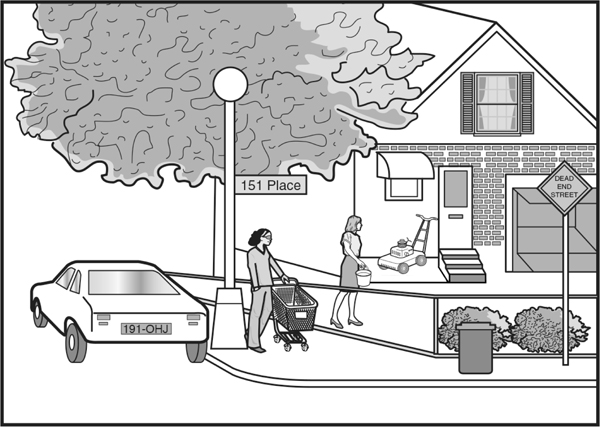
DO NOT PROCEED UNTIL 5 MINUTES HAVE ELAPSED
16.What street number is indicated on the lamppost?
(A)151
(B)15
(C)51
(D)None
17.The female on the sidewalk is
(A)pushing a shopping cart.
(B)carrying a shopping bag.
(C)carrying packages in her arms.
(D)a professional cook.
18.Where is the lawn mower in the scene?
(A)On the lawn
(B)On the sidewalk
(C)Next to the stoop
(D)There is none.
19.The house faces a
(A)one-way street.
(B)dead end street.
(C)major thoroughfare.
(D)play street.
20.The female wearing a skirt is located
(A)in the garage.
(B)on the stoop.
(C)next to the fence.
(D)in the driveway.
21.The first three numbers of the license plate on the car parked to the left of the lamppost are
(A)252.
(B)461.
(C)191.
(D)822.
22.The female on the sidewalk is
(A)wearing a skirt.
(B)wearing glasses.
(C)wearing a coat.
(D)wearing a jacket.
23.The female wearing a skirt is carrying
(A)a pocketbook.
(B)a pail.
(C)a package.
(D)a broom.
24.The garage door in the picture is
(A)open.
(B)closed.
(C)broken.
(D)half open.
25.The garbage can is located
(A)in the garage.
(B)in the driveway.
(C)on the sidewalk.
(D)There was none.
Directions: Answer questions 26 through 35 solely on the basis of the following narrative and Civilian Complaint Report. Some of the boxes on the form are numbered and others are not. The boxes are not necessarily consecutively numbered.
On Wednesday, July 8, at about 2230 hours, Mr. Manny Rodriquez, of 8207 First Avenue, Manhattan, Apartment 25, telephone number 262-4511, came to the Third Precinct station house to make a civilian complaint. The details are as follows:
At about 2200 hours, July 8, Mr. Rodriquez was walking south on Broadway at the intersection of Chambers Street. He had just finished work at the Gleem Computer Company of 280 Broadway, telephone number 374-0001, where he is employed as a key punch operator. He was on his way to the subway when he met a co-worker, Lydia James. Suddenly a uniformed police officer on foot patrol approached him. The officer took Mr. Rodriquez into City Hall Park and searched him. Ms. James, who lives at 322 Archer Street, Staten Island, telephone number 743-3304, witnessed the incident. She, however, became frightened and ran away.
According to the complainant, he was searched and then told by the police officer that he looked like a trouble maker and that the officer knew how to control “his kind.” The officer then pushed Mr. Rodriquez and told him to “beat it.”
Mr. Rodriquez was very upset and returned to his place of employment. There he met John Colon, his office supervisor. Mr. Colon told Mr. Rodriquez that he should report the incident to the precinct. Mr. Rodriquez agreed, but did not think he could do it because he did not speak English very well. Mr. Colon, who lives at 46-02 Bellow Street, Queens, telephone number 820-0603, said he would go to the precinct with Mr. Rodriquez and help explain the details.
They went to the Third Precinct station house and Mr. Rodriquez, with Mr. Colon’s help, restated what had taken place. Sergeant Howe had them prepare a Civilian Complaint Form and asked if Mr. Rodriquez could describe the police officer. He said he could. He said the officer was white, about five feet eight inches, with a shield number of 770. That was all he could remember.
At 2245 hours, Sergeant Howe called the complaint into the Civilian Complaint Review Board and spoke to Police Officer Wilson. The Civilian Complaint Review Board (C.C.R.B.) serial number of 2046 was assigned by Officer Wilson, whose shield number is 84. The sergeant thanked them for bringing the matter to his attention and said that the matter would be further investigated. Mr. Rodriquez and Mr. Colon left the station house at 2300 hours.
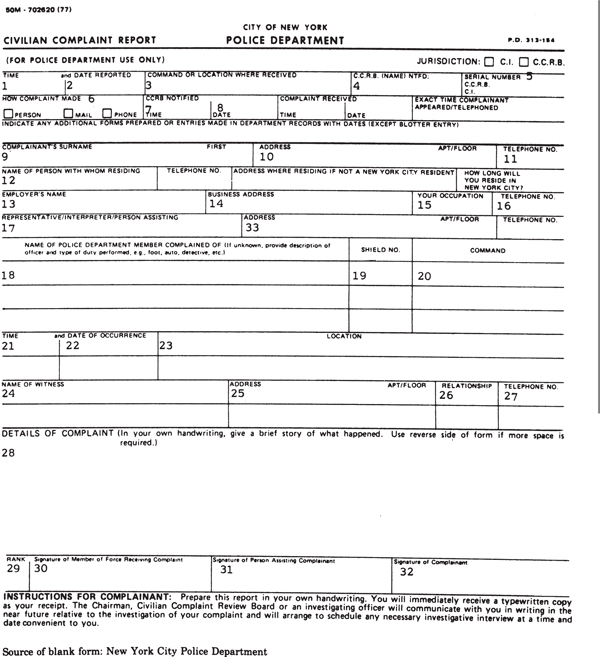
26.The Gleem Computer Company should be entered in Box number
(A)17.
(B)15.
(C)13.
(D)9.
27.The correct entry for Box 11 is
(A)743-3304.
(B)374-0001.
(C)820-0603.
(D)262-4511.
28.Mr. Colon’s address should be entered in Box number
(A)10.
(B)14.
(C)25.
(D)33.
29.The word “co-worker” would best be entered in Box number
(A)24.
(B)26.
(C)20.
(D)12.
30.The most accurate entry for Box 1 is
(A)2200.
(B)2230.
(C)2245.
(D)2300.
31.Police Officer Wilson’s name should be entered in Box number
(A)30.
(B)9.
(C)31.
(D)4.
32.The correct entry for Box 5 is
(A)770.
(B)84.
(C)2046.
(D)2300.
33.Which of the following persons is not required to sign the form?
(A)Sergeant Howe
(B)Mr. Colon
(C)Ms. James
(D)Mr. Rodriquez
34.Which of the following should not be entered in Box 18?
(A)Uniformed police officer
(B)On foot
(C)A male, white
(D)Five feet, eight inches
35.City Hall Park should be entered in Box number
(A)23.
(B)25.
(C)3.
(D)22.
Directions: Answer questions 36 through 45 solely on the basis of information recorded on the following Evidence Form.
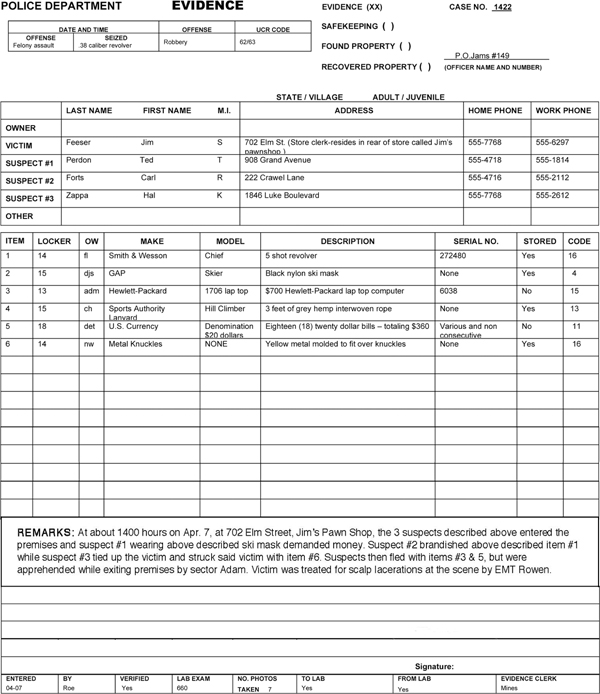
36.What is the victim’s address?
(A)908 Grand Avenue
(B)702 Elm Street
(C)222 Crawel Lane
(D)1846 Luke Boulevard
37.What was the name of the suspect who wore a ski mask?
(A)Jim Freeser
(B)Carl Forts
(C)Hal Zappa
(D)Ted Perdon
38.What was the name of the suspect who brandished a revolver?
(A)Hal Zappa
(B)Jim Freeser
(C)Carl Forts
(D)Ted Perdon
39.The victim was struck with
(A)a revolver.
(B)a blackjack.
(C)metal knuckles.
(D)a rope.
40.The items that have the same code are Items
(A)1, 2, 3, and 4.
(B)3 and 5.
(C)2 and 4.
(D)1 and 6.
41.The offenses involved in the alleged criminal actions of the suspects are best described by which of the following choices?
(A)Felony Assault and Robbery
(B)Larceny and Unlawful Imprisonment
(C)Coercion and Attempted Larceny
(D)Harassment and Extortion
42.The telephone number of Jim’s Pawn Shop is
(A)555-1814.
(B)555-2112.
(C)555-6297.
(D)555-2612.
43.The total value of the U.S. currency taken by the suspects in dollars is
(A)18.
(B)360.
(C)20.
(D)1,060.
44.The case number involved in this case is
(A)149.
(B)1422.
(C)1706.
(D)272480.
45.Which of the following statements is MOST CORRECT?
(A)Not all the items were stored.
(B)Carl Forts has a work number of 555-2162.
(C)All the items were returned to their rightful owner(s).
(D)Ted Perdon and Hal Zappa use their cell phone telephone numbers as their work phone numbers.
Directions: Answer questions 46 through 52 solely on the basis of the following information.
The police handling of family disputes has received an increasing amount of attention in recent years. Quite often, such situations involve complex decisions because of the potential for physical danger both to the police officer and the parties involved in the dispute.
In the past, when some police officers responded to scenes of family disputes, they invariably referred the people involved to Family Court without arresting anyone. Such handling was considered “the practical way” to handle these situations because, in a matter of days, hours, or even minutes, the antagonists would resolve their differences and reconcile. This prompted the people involved to feel that the police had not discharged their duties properly. Indeed, a lawsuit was instituted on behalf of some wives who felt that the police should have arrested their husbands instead of attempting to mediate the problem or refer it to court. In some instances the Department agreed that an arrest should have been made and, accordingly, the Department policy in this Bulletin was developed.
Department Policy
The victim of a criminal act which occurs in the home or involves another family member has the right to demand that police take appropriate action. This action may include an arrest. The fact that the persons involved are related should not matter. Accordingly, the following two situations demonstrate departmental policy with respect to the role of the police officer at the scene of a dispute involving a husband and a wife.
A. THE POLICE ARE SUMMONED TO A LOCATION, AND A SPOUSE (HUSBAND OR WIFE) OR SOMEONE ELSE HAS AN ORDER OF PROTECTION ISSUED PURSUANT TO THE FAMILY COURT ACT.
When the police arrive at the scene of a dispute where one of the parties alleges that he or she has an Order of Protection, they should ask for a copy of that Order. A police officer has a right to see the Order of Protection before making a decision as to how to proceed. The Order will indicate the type of conduct prohibited and its date of expiration. If the person to whom the order was issued (the Petitioner) asks the officer to arrest the offender (the Respondent) for violations of the Order, that Respondent must be taken into custody if there is probable cause to believe that the Order has been violated. The fact that the people involved are husband and wife may not be a factor in determining the existence of probable cause.
If the person who violated the Order is absent when the police arrive, normal procedures should be followed.
An Order of Protection may prohibit conduct which is not ordinarily criminal in itself. For instance, an Order may demand that the spouse not appear in an intoxicated condition before the children; not be present in a specific location; or not use abusive language in front of his or her spouse, children, etc. Arrests will be made in such situations even though the conduct is not criminal.
If an Order of Protection has been violated and the petitioner-victim does not want the respondent arrested, the officer should make an appropriate entry in his/her log book and ask the victim to sign it. If the victim refuses, the officer should write the words, “refused signature” in lieu of the person’s signature. Such an entry will serve to protect the police officer in the event of future legal action against the officer, the Police Department, or the City of New York since such an entry will permanently record the reason that no arrest was made.
B. THE POLICE RESPOND TO A SITUATION IN WHICH ONE SPOUSE ALLEGES THAT THE OTHER SPOUSE PUSHED, SHOVED, KICKED, STRUCK, OR OTHERWISE PHYSICALLY ABUSED HIM OR HER.
If the dispute involves some type of physical abuse, such as pushing, shoving, kicking, or punching; but there is no physical injury, the offense involved is harassment. Harassment is a violation, but must have occurred in the presence of an officer for an arrest to be made legally. In cases of this nature, the complaining party should be referred to Family Court for an Order of Protection, or to the Summons Part of the Criminal Court of the City of New York.
BY DIRECTION OF THE POLICE COMMISSIONER
DISTRIBUTED TO ALL COMMANDS
46.In the past, “the practical way” to handle family disputes was considered
(A)arresting everyone concerned.
(B)disregarding violations of law.
(C)informal mediation since the antagonists would soon resolve their differences.
(D)referring those involved to Family Court without arresting anyone.
47.On December 11, Officer Paula Parker responds to the home of Mrs. Virginia Blake. Mrs. Blake possesses a valid Order of Protection to prohibit her husband, Otto Blake, from being in her residence. Mr. Blake is in the house and has possession of a deed for the house which indicates that he is co-owner. Mrs. Blake wants her husband arrested. Mr. Blake is now quite willing to leave and never return. Officer Parker, after considering the above facts, arrests Otto Blake.
Based upon the above information, Officer Parker’s action in this case was
(A)proper, since the Order of Protection was violated and Mrs. Blake wants an arrest made.
(B)improper, since Otto Blake is a co-owner of the house.
(C)proper, since Otto Blake is known by the officer to beat his wife.
(D)improper, since Otto Blake’s conduct is not criminal.
48.Family disputes often involve complex decisions because they have the potential for
(A)future legal action against the police officer and the City of New York.
(B)physical danger to the police and the parties involved.
(C)a continuing drain on police resources.
(D)a drain on the resources of the courts.
49.At 0930 hours, on August 19, Officer Rudolph Martin is dispatched to 2914 Powell Street in the Borough of Brooklyn. This address is Mr. and Mrs. James Wilson’s residence. Upon arrival, Officer Martin is told by James Wilson that while trying to sleep the previous night, he was repeatedly shoved off the bed by his wife, Edna Wilson. Although he did not receive physical injury, he wanted his wife arrested for physical abuse.
Based upon the above information, Officer Martin should
(A)arrest Edna Wilson since she has no legal right to abuse her husband.
(B)refer James Wilson to Family Court or Criminal Court.
(C)personally mediate the case.
(D)call his supervisor to the scene for assistance.
50.The department policy concerning the proper handling of disputes involving husbands and wives was developed as a result of
(A)a lawsuit.
(B)a recently enacted statute.
(C)a court decision.
(D)political pressure.
51.On January 13, Police Officer John Dackson of the 39th Precinct responded to a call at the apartment of Julia Simpson. Julia Simpson wanted her husband, Harry Simpson, who was sleeping on her couch, arrested for violating an Order of Protection which she obtained from Family Court Judge Adams on January 7. Officer Dackson requested to see the Order of Protection, and Mrs. Simpson refused to show it to him. Based on Mrs. Simpson’s refusal to show the order, the officer refused to arrest Harry Simpson.
Based upon the previous information, Officer Dackson’s actions were
(A)proper, since all civilians must obey the police.
(B)improper, since Mrs. Simpson states that she has the Order of Protection.
(C)proper, since Officer Dackson has a right to see the Order of Protection.
(D)improper, since Mr. Simpson was present in the house at the time.
52.If an Order of Protection has been violated and the victim who possesses the order does not want the respondent arrested, the officer should
(A)arrest the respondent anyway.
(B)talk the victim into changing his/her mind.
(C)take no further action and resume patrol.
(D)make an appropriate log entry and ask the victim to sign it.
Directions: The paragraph below contains questions 53–55 in the form of three numbered blanks. Immediately following the paragraph are lists of four word choices that correspond to these numbered blanks. Select the word choice that would MOST appropriately fit the numbered blank in each question.
During his tour of duty, Police Officer Green is called to the scene of an injured civilian because he is the only police officer on duty in that area of the precinct. The civilian, Mr. Tom Roe, has slipped on some water which is leaking from a public water fountain. Upon arrival at the scene, Q 53 calls his supervisor, Sergeant Carter, and requests that an ambulance respond to the scene to examine the injured Mr. Roe. An ambulance responds from Bayside Hospital with Emergency Medical Technician Bailes. Q 54, who was injured, was taken to the hospital for treatment of a dislocated shoulder. Doctor Smith treated Mr. Roe, who was Q 55 later in the day and went home.
53.(A)Carter
(B)Green
(C)Smith
(D)Someone
54.(A)Mr. Green
(B)Mr. Bailes
(C)Mr. Roe
(D)Mr. Smith
55.(A)hospitalized
(B)released
(C)transported
(D)examined
Directions: Answer questions 56 and 57 solely on the basis of the following police procedures.
Upon responding to a crime that may require safeguarding evidence and detaining witnesses for further investigation, the responding patrol officer shall perform the following steps, in this order:
1.Request response, through the communications dispatcher, of
a.the patrol supervisor and then
b.the detectives.
2.Remove unauthorized persons from the area and secure the crime scene.
a.Evidence found at the scene shall not be disturbed.
3.Detain witnesses and persons with information pertinent to the crime.
4.Make appropriate entries in memo book of
a.observations made,
b.identity of suspects/witnesses with addresses and telephone numbers, and
c.any relevant statements made whether casually or as a formal statement by a witness.
5.Advise the patrol supervisor and detectives of
a.identity of witnesses detained and
b.other information regarding the case.
6.Assess the crime scene.
7.Determine if the services of the Crime Lab Unit are required.
56.Patrol Officer Lynda Chan responds to a report of a past homicide of a bodega owner shot and killed during a robbery. It is clear that the establishment of a crime scene in and around the bodega will be required. Officer Chan correctly follows the appropriate procedure and has detained a witness to the crime. According to the procedure, the officer should next
(A)advise the patrol supervisor.
(B)make appropriate entries in her memo book.
(C)assess the crime scene.
(D)advise the detectives.
57.At the scene of a brutal sexual assault on a minor, Patrol Officer Donald Clark, who has just completed his probationary period, is the first officer to respond. Although this is the first time he has responded to such a crime, he follows correct procedure and properly requests the response of the patrol supervisor, Sergeant Hanna Montez. Officer Clark then requests that Sergeant Montez have the detectives respond to assist in the investigation. In this instance, Officer Clark acted
(A)properly, mainly because of the nature of the crime.
(B)improperly, mainly because the request for the response of the detectives should have been made through the communications dispatcher.
(C)properly, mainly because Officer Clark is relatively new to the Department.
(D)improperly, mainly because the crime scene should have been assessed before any request for the response of the detectives was made.
Directions: Answer questions 58 and 59 solely on the basis of the following information.
At a crime scene, if the services of the Crime Lab Unit are required by patrol officers, then such officers will adhere to the following procedure:
1.The Crime Lab Unit will be requested for the following incidents:
a.any homicide
b.any forcible rape
c.any robbery with any injury to the victim of the robbery or any hijacking with any injury caused by a firearm
d.an aggravated assault with a dangerous instrument and the victim is likely to die
e.any burglaries involving forced safes or circumvented alarms
f.criminal mischief where property damage is more than $1000 or for any amount of damage resulting from a hate crime
g.any injury or damage to property resulting from criminal mischief caused by a terroristic act which has been declared as such by the patrol supervisor
2.A request for the Crime Lab Unit to respond to a crime scene shall be made by a patrol officer at the crime scene directly by telephone. If unable to make such request by telephone for any reason, then the officer shall make the request by portable radio through the communications dispatcher. Any such request shall include the following information given in the following order:
a.the exact location of the crime scene
b.the time and date of occurrence of the incident
c.type of crime committed and type of weapons if used
d.number of victims involved
e.name of the hospital treating persons removed from the scene
58.Officer Moe Borak responds to a past robbery of a gas station where the station attendant tells the officer that two men entered the office of the gas station as if to buy a lottery ticket and then robbed him of $1500 at knife point. The attendant, although uninjured, further tells the officer that he believes the men were terrorists because they were shouting, “Death to America,” as they left. Officer Borak wastes no time and calls for the services of the Crime Lab Unit. In this instance, Officer Borak acted
(A)properly, mainly because of the dollar value of the robbery.
(B)improperly, mainly because the attendant was not injured.
(C)properly, mainly because it involved an act of suspected terrorism.
(D)improperly, mainly because there was no firearm involved.
59.Under the appropriate circumstances Officer Lucy Bando is making a request for the Crime Lab Unit to respond to a crime scene. In this instance she correctly makes the request via her portable radio to the communications dispatcher. She has just given the exact location of the crime scene. What information should she give next?
(A)If weapons were used, the type of weapon(s)
(B)The number of any victims involved
(C)The type of crime committed
(D)The time and date of occurrence
Directions: Answer questions 60 through 66 solely on the basis of information contained in the following Operations Order.
TO ALL COMMANDS
SUBJECT: CONFLICT RESOLUTION DISPUTE CENTERS—
MANHATTAN AND BRONX COMMANDS
1.The Institute for Mediation and Conflict Resolution (IMCR) Dispute Center, located at 435 West 144th Street, Manhattan, provides a police officer in a Manhattan or Bronx command with an option to have a dispute mediated rather than to issue a summons or effect an arrest when dealing with an interpersonal dispute.
2.Cases that qualify for IMCR mediation are disputes between family members, tenants, acquaintances, common law relationships, neighbors, friends, and co-workers. IMCR Center personnel also mediate referrals involving strangers, particularly where a form of restitution can be awarded. Under the mediation resolution procedure, the following misdemeanors and/or violations are amenable to mediation referral:
A. |
Assault—3rd Degree |
B. |
Menacing |
C. |
Reckless Endangerment—2nd Degree |
D. |
Reckless Endangerment of Property |
E. |
Misapplication of Property |
F. |
Criminal Mischief—4th Degree |
G. |
Aggravated Harassment |
H. |
Harassment |
I. |
Disorderly Conduct |
J. |
Trespass |
K. |
Criminal Trespass—2nd and 3rd Degree |
L. |
Custodial Interference—2nd Degree |
3.In non-arrest cases referred to IMCR, uniformed members of the service will direct the complainant to the appropriate geographical IMCR office, where a “Request to Appear” application may be prepared as part of the mediation process. The locations of IMCR Centers, and their area of jurisdiction, are as follows:
a.MANHATTAN—Complainants residing south of 110th Street (street numbers lower than 110) in Manhattan will be referred to the IMCR Dispute Center Office, 346 Broadway, New York, New York (1st Floor).
Complainants residing north of 110th Street (street number of 110 or higher) in Manhattan will be referred to the IMCR Dispute Center Office, 425 West 144th Street, New York, New York (4th Floor).
b.BRONX—Complainants residing within Bronx commands will be referred to the IMCR Dispute Center Office located in Room M-4, Bronx Criminal Court Building, 216 East 161st Street, Bronx, New York.
4.IMCR screens each complaint application to determine if the case is amenable to mediation. If a case is not amenable to mediation, IMCR personnel will refer a complainant to the Office of Court Administration for further action.
BY DIRECTION OF THE POLICE COMMISSIONER
DISTRIBUTION
All Commands
60.Which of the following misdemeanors or violations is not amenable to mediation referral?
(A)Any disorderly conduct charge
(B)Any menacing charge
(C)Any assault charge
(D)Any harassment charge
61.Police Officer Charles Brown, shield #666, is working a day tour in the 89th Precinct in Brooklyn. His assignment is patrol post 16. At 1030 hours, he comes upon a dispute in the street between two friends. The dispute centers around an act of Disorderly Conduct. With the consent of both parties, Officer Brown elects to refer the dispute to the Institute for Mediation and Conflict Resolution.
Based upon the above information, Officer Brown’s action in this case was
(A)proper, since the dispute centered around an act of Disorderly Conduct.
(B)improper, since Officer Brown is working in a Brooklyn command.
(C)proper, since the parties in the dispute are friends.
(D)improper, since the procedure does not apply to disputes in the street.
62.If IMCR personnel decide that a dispute is not amenable to mediation, a complainant is referred to
(A)the police.
(B)the Office of Court Administration.
(C)the district attorney’s office.
(D)the appropriate criminal court.
63.The decision on whether to refer a dispute to the Institute for Mediation and Conflict Resolution is made by
(A)the parties to the dispute.
(B)the party in the dispute against whom the misdemeanor or violation was committed.
(C)both parties in the dispute, as well as the police officer.
(D)the police officer.
64.This new conflict resolution procedure was introduced in the police department by
(A)the Institute for Mediation and Conflict Resolution.
(B)the Manhattan and Bronx Criminal Courts.
(C)the police commissioner.
(D)Not stated
65.Police Officer Margaret Dwyer, shield #816, is performing an evening tour of duty out of the 96th Precinct in Manhattan. At approximately 1915 hours, she is dispatched to 2312 87th Street, apartment 3F. Upon arrival she encounters a common law husband and wife having a dispute concerning a possible trespass into the apartment by the husband. Since both parties thought it was a good idea, Officer Dwyer exercised her option and referred the dispute to the IMCR Dispute Center Office at 425 West 144th Street, New York (4th Floor).
Based upon the above information, Officer Dwyer’s action in this case was
(A)proper, since the Center accepts cases involving common law relationships.
(B)improper, since the case is not amenable for mediation.
(C)proper, since both parties thought it was a good idea.
(D)improper, since the officer referred the disputants to the wrong location.
66.What police department commands received copies of this order?
(A)All Commands
(B)All Manhattan and Bronx Commands
(C)All Patrol Commands
(D)Not stated
Directions: Answer questions 67 through 76 solely on the basis of information recorded in the following “Desk Appearance Ticket Investigation.”
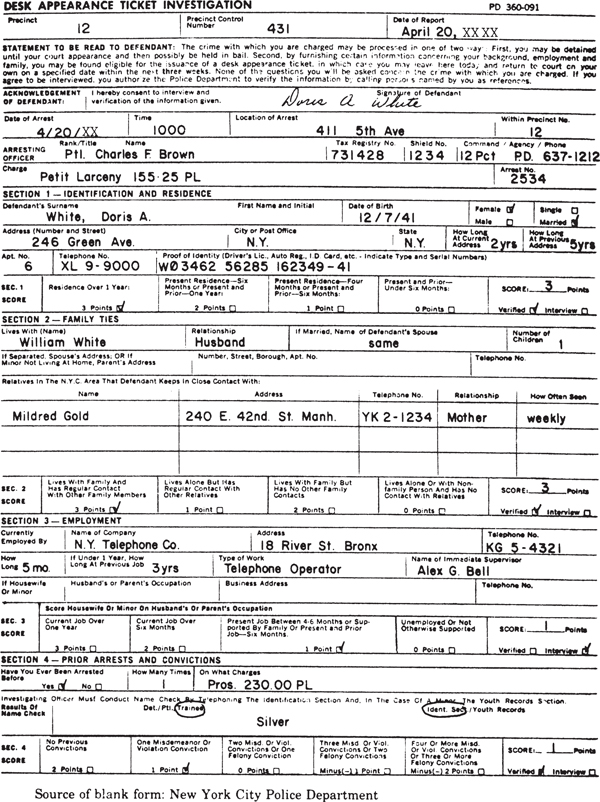
67.The arresting officer’s last name is
(A)Silver.
(B)Brown.
(C)Gold.
(D)White.
68.The charge is
(A)Prostitution 230.00 PL.
(B)Burglary 140. PL.
(C)Petit Larceny 155.25 PL.
(D)Assault 125.05 PL.
69.The defendant lives with her
(A)mother.
(B)brother.
(C)sister.
(D)spouse.
70.The defendant is employed by
(A)a telephone company.
(B)a computer company.
(C)a driving school.
(D)a beauty parlor.
71.The defendant’s home telephone number is
(A)KG5-4321.
(B)XL9-9000.
(C)637-1212.
(D)731-4280.
72.The defendant has lived at
(A)240 E. 42nd Street for 3 years.
(B)18 River Street for 1 year.
(C)246 Green Avenue for 2 years.
(D)1840 Apple Street for 5 years.
73.The arrest number for this case is
(A)431.
(B)2354.
(C)341.
(D)2534.
74.The date of this arrest is
(A)April 2.
(B)April 12.
(C)April 20.
(D)Not stated.
75.The arresting officer’s shield number is
(A)731428.
(B)3241.
(C)371824.
(D)1234.
76.The name of the defendant’s immediate supervisor at her place of employment is
(A)Bell.
(B)Gold.
(C)White.
(D)Silver.
Directions: Answer questions 77 through 80 solely on the basis of the following Operations Order.
TO ALL COMMANDS
SUBJECT: ENERGY CONSERVATION PREVENTIVE
MAINTENANCE PROGRAM
1.In an effort to conserve energy and yet maintain comfortable working conditions and improve department facilities, deficiencies in building maintenance and/or cleaning (particularly those affecting air conditioning and energy waste) should be reported so that repairs may be made.
2.Therefore, all commanding officers will conduct a physical inspection of facilities under their respective jurisdictions. The inspection should focus on conditions which directly affect the department’s energy costs, such as, but not limited to:
a.an imbalance in the heating/cooling system in new buildings,
b.faulty or broken thermostats,
c.broken windows and/or doors, particularly those leading from air conditioned to non-air conditioned spaces,
d.faulty lights,
e.blockage of air vents supplying cooled air,
f.display of educational posters relative to federal energy regulations concerning temperature,
g.condition of window air conditioner filters.
3.In addition, commanding officers concerned are requested to instruct subordinate personnel to conform to the following energy conservation guidelines:
a.use air conditioning equipment only when outside temperature exceeds 80 degrees Fahrenheit,
b.adjust window air conditioner settings at no less than 78 degrees Fahrenheit, and set thermostats midway between the warm and cool settings,
c.do not set window air conditioners on constant run position,
d.ensure that pre-season filter maintenance is performed on window air conditioners and that fresh air louvers are kept in “closed” position on hot days,
e.do not turn on air conditioners prior to 1000 hours in commands not operating on a 24-hour basis. These air conditioners should be shut off at least one-half hour prior to closing time,
f.keep blinds and shades closed to prevent air conditioned space from being exposed to sunlight,
g.inspect windows and interior doors leading from air conditioned to non-air conditioned rooms, to prevent loss of cooled air when air conditioners are operating,
h.do not permit unauthorized personnel to tamper with central air conditioner settings. These settings are preset by Building Maintenance Section personnel.
BY DIRECTION OF THE POLICE COMMISSIONER
DISTRIBUTION
All Commands
77.Deficiencies in building maintenance and/or cleaning should be reported for all of the following reasons except
(A)to increase employee morale.
(B)to conserve energy.
(C)to improve the appearance of department facilities.
(D)to maintain comfortable working conditions.
78.Police Officer James Jones is working a day tour in an office in police headquarters. While the office has central air conditioning, the air conditioning does not seem to be working properly. It is 92°F outside, and Officer Jones and his fellow workers are sweltering. Although Jones is not sure what to do, he sees nothing wrong with trying to adjust the central air conditioner settings.
Based upon the above information, Officer Jones’s decision to adjust the settings is
(A)proper, since it is above 78°F outside.
(B)improper, since he is not authorized to adjust the central air conditioner settings.
(C)proper, since his fellow workers are also involved.
(D)improper, since the outside temperature is not warm enough.
79.At 0900 hours on August 14, Police Officer Mary Smith reported for work at the 89th Precinct. It is already 76°F outside, and the temperature is predicted to rise to the high eighties. Officer Smith turns on her window air conditioner and sets the thermostat midway between the warm and cool settings.
Based upon the above information, Officer Smith’s actions were
(A)proper, since she set the thermostat correctly.
(B)improper, since she is not authorized to touch the air conditioner setting.
(C)proper, since it is so hot outside.
(D)improper, since it is only 76°F outside.
80.A physical inspection is required to detect any conditions which affect
(A)the police officers’ morale.
(B)the department’s energy costs.
(C)conservation guidelines.
(D)physical safety.
Directions: Answer questions 81 through 90 solely on the basis of the legal definitions given below. Do not base your answers on any other knowledge of the law you may have. You may refer to the definitions when answering the questions.
crime Either a misdemeanor or a felony.
misdemeanor An offense for which a person can be sentenced to imprisonment for periods of time from 16 days to one year.
felony An offense for which a person can be sentenced to imprisonment for more than one year. Felonies are classified as either A, B, C, D, or E. An A felony is more serious than a B felony, and so on.
violation An offense for which a sentence of imprisonment of no more than 15 days can be given.
offense An act which is prohibited by the Penal Law. Offenses are felonies, misdemeanors, or violations.
physical injury An impairment of a physical condition, or a condition causing substantial pain.
serious physical injury A physical injury which involves a substantial risk of death, a protracted disfigurement, or an impairment of an organ.
deadly weapon Any loaded gun, capable of firing a shot which can cause death or serious physical injury; or a switchblade knife, billy, blackjack, or metal knuckles.
dangerous instrument Any article or substance (including a vehicle) which, depending upon circumstances, is capable of causing death or serious physical injury.
81.The most severe punishment is given for a
(A)felony.
(B)violation.
(C)misdemeanor.
(D)felony or violation, depending upon the age of the perpetrator.
82.A deadly weapon is
(A)any gun capable of firing a shot which can cause death.
(B)a billy.
(C)a vehicle.
(D)a hunting knife.
83.John has been convicted of a felony. He would receive the greatest punishment available if he were convicted of
(A)an “E” felony.
(B)a “C” felony.
(C)an “A” felony.
(D)a “D” felony.
84.A crime is
(A)always a felony.
(B)always a misdemeanor.
(C)either a misdemeanor or a felony.
(D)neither a misdemeanor nor a felony.
85.One thing that a felony, misdemeanor, and violation have in common is that they
(A)are crimes.
(B)have a maximum punishment stated in their respective definitions.
(C)require the prosecutor to set the maximum sentence.
(D)are offenses.
86.Which of the following is a false statement?
(A)Every serious physical injury involves a physical injury.
(B)If substantial pain occurs, a physical injury has taken place.
(C)Every physical injury involves a serious physical injury.
(D)If there is an impairment of a physical condition, a physical injury has occurred.
87.Which of the following statements is most accurate?
(A)The use of a deadly weapon always causes physical injury.
(B)The use of a dangerous instrument always causes physical injury.
(C)The use of a dangerous instrument always causes serious physical injury.
(D)The use of a deadly weapon may cause no injury.
88.All of the following could be considered a deadly weapon except
(A)a switchblade knife.
(B)a billy.
(C)a hammer.
(D)metal knuckles.
89.Consider the following statements and select the least inaccurate statement.
(A)Under certain circumstances, a bottle of soda could be a deadly weapon.
(B)Under certain circumstances, an ax would be a dangerous instrument; but it could never be a deadly weapon.
(C)A blackjack is a deadly weapon but could never be a dangerous instrument.
(D)Any article could be either a dangerous instrument or a deadly weapon depending upon the circumstances under which it is used.
90.If Joe Jones was convicted of an offense and sentenced to 10 days imprisonment, he was convicted of a
(A)violation.
(B)misdemeanor.
(C)felony.
(D)Cannot be determined.
Directions: Answer questions 91 and 92 solely on the basis of the following.
burglary in the second degree A person is guilty of this crime when he knowingly enters or remains unlawfully in a building with intent to commit a crime therein. He is also guilty of this crime when, in effecting the entry or while inside the building or while in immediate flight, he or another participant is armed with explosives or a deadly weapon, or uses a dangerous instrument, or causes physical injury to someone who is not a participant. (A dwelling is considered a building wherein a person usually lodges overnight.) Burglary in the second degree is a Class C felony.
On July 10, at 10 A.M., Spencer Marlond and Bob Kew climb in the open bedroom window of Jane Adams’s residence. Ms. Adams is in the bathroom taking a shower when the two men enter looking for valuables. She does not hear them enter. Marlond and Kew quickly go through her dresser drawers and remove a gold locket worth $280. They also remove $221 in U.S. currency. Kew has previously been convicted of burglary twice, and has vowed that he will never go to jail again. Kew has a switchblade knife in his jacket pocket and is ready to use it. Marlond has no knowledge of Kew’s past criminal record, nor that Kew is carrying a deadly weapon. The two men leave through Ms. Adams’s front door; they escape without being observed.
91.Based upon the above information, which of the following is the most accurate statement?
(A)Both men are guilty of burglary in the second degree since the total value of the property taken is more than $500.
(B)Kew is guilty of burglary in the second degree since he is carrying the switchblade knife; but Marlond, who knew nothing of the weapon, is not.
(C)Kew and Marlond would be guilty of burglary in the second degree only if Kew used the switchblade knife against Adams.
(D)If the two men had been discovered after entering the bedroom and had fled without taking property, they would still be charged with burglary in the second degree.
92.Based on the preceding definition and narrative, which of the following statements is false?
(A)No crime was committed because Ms. Adams left her windows open.
(B)The fact that the crime occurred at 10 A.M. has no bearing on the charge.
(C)If Ms. Adams had not been home, the scene of the crime would still be considered a “dwelling.”
(D)Kew’s prior record has no bearing on the charge.
Directions: Answer question 93 solely on the basis of the following information.
A private person may use deadly physical force to defend himself or another person against the imminent use of deadly physical force. Deadly physical force is the kind of force which produces death or the kind of injury which may cause death.
93.Peter and Paul are walking through Central Park. Tom, a former employee of Paul’s, sees them and tells them to stop. He is angry with Paul, and tells Paul that he wants his job back. Tom further tells Paul that if he does not get his job back the next day, he is going to kill him. Peter intercedes and tells Tom to calm down. Tom says he has no quarrel with him, but if he (Peter) wants to get involved, he will kill them both the next day. Peter and Paul then leap on Tom and begin to beat him. Tom dies as a result of the beating.
Based upon the above information, Peter and Paul were
(A)justified, since Tom had threatened them with death.
(B)not justified, since Paul had a right only to defend himself; Peter should not have interfered.
(C)justified, since a person may defend himself or another person against deadly physical force.
(D)not justified, since Tom had not threatened the imminent use of deadly physical force.
Directions: Answer questions 94 and 95 solely on the basis of the following information.
A private person may use deadly physical force to arrest a person who has committed robbery, forcible rape, forcible sodomy, and who is in immediate flight therefrom.
94.Maryann is asleep in her apartment. A male picks the lock of her door, enters, wakes her, and rapes her at knifepoint. The male escapes, and Maryann does not report the crime to the police. Instead she applies for, and receives, a pistol permit. Several months later, she sees the male who raped her. She confronts him and tries to make a citizen’s arrest. When he tries to run away, Maryann kills him with her licensed handgun.
Based upon the above information, were Maryann’s actions justified?
(A)Yes, since the male was the person who forcibly raped her.
(B)No, since she did not originally report the rape to the police.
(C)Yes, since the gun she used was licensed.
(D)No, since the male was not in immediate flight from the rape.
95.John is returning home from a hunting trip. He is legally carrying a rifle. He hears a noise in an alley, and sees a man running from it. He goes into the alley and encounters an old woman who tells him that a man just attempted to rob her with a knife. The old woman then points down the street and says, “That’s him.” John wants to arrest the man so he loads the rifle, fires one shot, and kills the man.
Based upon the above information, were John’s actions justified?
(A)Yes, since John legally possessed the rifle.
(B)No, since a private person is not authorized to use deadly physical force to arrest for an attempted robbery.
(C)Yes, since the old woman would have been robbed if it had not been for John.
(D)No, since John should have first fired a warning shot into the air.
Directions: Answer questions 96 and 97 solely on the basis of the following.
Robbery in the first degree occurs when a person forcibly takes the property of another person and, while committing the crime or in immediate flight therefrom, he or another participant causes serious physical injury to someone who is not a participant, or is armed with a deadly weapon, or uses a dangerous instrument against someone who is not a participant. Robbery in the first degree is a Class B felony.
96.Harold enters a supermarket and tells the manager to open the safe and give him the money. Harold is armed with a 0.38 caliber revolver, which is a deadly weapon. He fires one shot into the ceiling, takes the money from the manager, and escapes in an automobile driven by a female accomplice.
Based upon the above information, which of the following is the most accurate statement?
(A)Harold committed robbery in the first degree since he had an accomplice with him in the robbery.
(B)Harold committed robbery in the first degree since he used an automobile to escape.
(C)Harold committed robbery in the first degree since he was armed with a deadly weapon.
(D)Harold committed robbery in the first degree since he damaged property in the course of the robbery.
97.Which of the following is the least accurate statement concerning the crime of robbery in the first degree?
(A)Property must be taken for the crime to be committed.
(B)Someone must be injured for the crime to be committed.
(C)Robbery in the first degree is a Class B felony.
(D)A person does not need an accomplice to commit robbery in the first degree.
Directions: Answer questions 98 through 100 solely on the basis of the following.
The two powers that the police have that set them apart from ordinary citizens is the power of arrest and the authority to use legal force. Since the authority to use legal force leaves much potential for abuse, the necessity to have strict guidelines regulating the use of the police revolver is very pressing. The following guidelines are typical of those that exist in most police departments today. They are not meant to restrict a police officer in the performance of his/her lawful duty, but are intended to reduce shooting incidents and, consequently, protect life and property. In every case, department policy requires only the minimum amount of force be used consistent with the accomplishment of the mission.
In addition to Penal Law restrictions on the use of deadly physical force, police officers will adhere to the following guidelines concerning the use of firearms:
1.Use all means before using firearm when effecting arrest to prevent or terminate a felony, or when defending self or others.
2.Do not fire warning shots.
3.Do not discharge firearm to summon assistance, except when safety is endangered.
4.Do not discharge firearm from or at a moving vehicle unless occupants are using deadly physical force against officer or another by means other than a vehicle.
5.Do not discharge firearm at dogs or other animals unless there is no other way to bring the animal under control.
6.Do not discharge firearm if innocent persons may be endangered.
98.The above guidelines are meant to
(A)restrict an officer’s performance.
(B)protect life and property.
(C)eliminate the need to discharge firearms.
(D)prevent all abuses from occurring.
99.In addition to the above guidelines, other restrictions on the use of firearms can be found in
(A)The Code of Criminal Procedure.
(B)The City Charter.
(C)The Penal Law.
(D)The Administrative Law.
100.Police officers are always forbidden to
(A)discharge firearms to summon assistance.
(B)fire warning shots.
(C)fire shots from a moving vehicle.
(D)fire shots at animals.
101.Police Officer Booker arrives at the scene of a robbery at the Apex Bank where an eyewitness relates the following information to the officer.
| Suspect | |
| Gender: | Female |
| Race: | White |
| Height: | 5′10″ |
| Weight: | 140 lbs. to 150 lbs. |
| Hair: | Brown |
| Clothing: | Tan jacket, white slacks |
| Weapon: | .32 caliber pistol |
Officer Booker is completing a report on the incident. Which one of the following expresses the above information most clearly and accurately?
(A)A white female weighing 140–150 pounds robbed the Apex Bank. She was a female who was white with a tan jacket and white slacks and was 5′10″ tall. She had a .32 caliber pistol.
(B)A white female weighing 140–150 pounds robbed the Apex Bank with a .38 caliber pistol. She was 5′10″ tall and had brown hair and wore a tan jacket and white slacks.
(C)A white female, 5′10″ tall, weighing 140–150 pounds, robbed the Apex Bank. She was armed with a .32 caliber pistol, had brown hair, and wore a tan jacket and white pants.
(D)A white female, 5′10″ tall, weighing 140–150 pounds, robbed the Apex Bank. She had brown hair and was wearing a tan jacket, white pants, and a .32 caliber pistol.
102.Police Officer Rays is sent to investigate vandalism to the side of a private home. As a result of interviewing the owner and complainant, Mr. Rems, at 10:30 A.M., the officer obtains the following information:
| Place of occurrence: | 207 West 258 Street |
| Time of occurrence: | 9:30 A.M. |
| Time of reporting: | 10:30 A.M. |
| Crime: | Criminal Mischief |
| Exact damage: | Grease sprayed on the walls of the house |
| Only witness: | Mae Bells of 209 West 258 Street |
| Suspect: | A male Hispanic between 19 and 20 years old |
Officer Rays is preparing a report on the incident. Which one of the following expresses the above information most clearly and accurately?
(A)At 10:30 A.M. a male Hispanic between 19 and 20 years old was seen by a witness, Mae Bells of 209 West 258 Street, committing the crime of Criminal Mischief by spraying grease on the walls of a house at 207 West 258 Street, owned by the complainant, Mr. Rems.
(B)At 9:30 A.M. a male Hispanic between 19 and 20 years old was seen by a witness, Mae Bells of 207 West 258 Street, committing the crime of Criminal Mischief by spraying grease on the walls of a house at 209 West 258 Street, owned by the complainant, Mr. Rems.
(C)At 10:30 A.M. the complainant, Mr. Rems, reported that a male Hispanic between 19 and 20 years old was seen by a witness, Mae Bells of 209 West 258 Street. The crime of Criminal Mischief was committed by spraying grease on the walls of a house at 207 West 258 Street.
(D)At 10:30 A.M. the complainant, Mr. Rems, reported that a male Hispanic between 19 and 20 years old was seen by a witness, Mae Bells of 209 West 258 Street, committing the crime of Criminal Mischief by spraying grease on the walls of a house at 207 West 258 Street.
103.The radio dispatcher directs Officer Banks to respond to investigate a missing person from the Lily Nursing Home. The following information is obtained by the officer:
| Name of missing person: | Don Grime, resident of nursing home |
| Age: | 75 years old |
| Height: | 6′ |
| Weight: | 200 lbs. |
| Information provided by: | Ms. Green, Nursing Supervisor |
| Results of case: | Subject was found by custodial staff in the basement gym of the nursing home ten minutes after the officer arrived |
The officer is preparing a report on the incident. Which one of the following expresses the above information most clearly and accurately?
(A)I responded to the Lily Nursing Home and determined that Don Grime, a resident of the nursing home, was missing. He was found in the basement gym by the custodial staff and was 75 years old and was weighing 200 pounds and is 6′ tall. The information was provided by Ms. Green, the Nursing Supervisor.
(B)I responded to the Lily Nursing Home and was informed by Ms. Green, the Nursing Supervisor, that Don Grime, a resident of the nursing home, 75 years old, 200 pounds, and 6′ tall, was missing. He was found by the custodial staff in the basement gym ten minutes after I arrived.
(C)Ten minutes after I arrived at the Lily Nursing Home, I was informed by Ms. Green, the Nursing Supervisor, that Don Grime, a resident of the nursing home, 75 years old, 200 pounds, and 6′ tall, was missing. He was found in the basement gym by the custodial staff.
(D)Ten minutes after I arrived at the Lily Nursing Home, Don Grime, a resident of the nursing home, 75 years old, 200 pounds, and 6′ tall, was found to be missing. I was informed by Ms. Green, the Nursing Supervisor, that he was found in the basement gym by the custodial staff.
104.At 8:30 P.M., Officer Knight responds to a past larceny of an auto. Officer Knight obtains the following information regarding the incident:
| Time of occurrence: | 8:00 P.M. |
| Place of occurrence: | Intersection of Taylor Avenue & Market Street |
| Complainant and witness: | Frank Parks |
| Owner of vehicle: | June Parks |
| Vehicle description: | Blue Ford Pickup Truck |
| Perpetrators: | Two white males |
The officer is preparing a report on the incident. Which one of the following expresses the above information most clearly and accurately?
(A)At 8:00 P.M., a blue Ford pickup truck was stolen at the intersection of Taylor Avenue and Market Street. At 8:30 P.M., June Parks, the owner of the vehicle who witnessed the crime, reported to me that two white males stole the vehicle.
(B)At 8:30 P.M., a blue Ford pickup truck was stolen at the intersection of Taylor Avenue and Market Street. Frank Parks, who witnessed the crime, reported to me that two white males stole the vehicle.
(C)At 8:00 P.M., a blue Ford pickup truck was stolen by two white males. At 8:30 P.M. at the intersection of Taylor Avenue and Market Street, Frank Parks, the owner of the vehicle, reported the crime to me.
(D)At 8:30 P.M., Frank Parks reported to me that he witnessed at 8:00 P.M. two white males stealing a blue Ford pickup truck. The vehicle, which is owned by June Parks, was stolen at the intersection of Taylor Avenue and Market Street.
105.Officer Rivers comes upon an assault in progress. The details of the incident are as follows:
| Time of occurrence: | 9:30 P.M. |
| Location: | In front of 899 3rd Avenue |
| Victim: | Frank Baron |
| Suspects: | The Melford Guys Street Gang |
| Weapons: | Chains and bats |
| Additional information: | Victim was treated and released at Sunrise Hospital |
The officer is preparing a report on the incident. Which one of the following expresses the above information most clearly and accurately?
(A)At 9:30 P.M., in front of 899 3rd Avenue, Frank Baron was assaulted with chains and bats. He was released after being treated at Sunrise Hospital. Suspected in the assault are members of the Melford Guys Street Gang.
(B)At 9:30 P.M., members of the Melford Guys Street Gang were in front of 899 3rd Avenue, when chains and bats struck Frank Baron. He was released after being treated at Sunrise Hospital.
(C)Frank Baron was released after being treated at Sunrise Hospital at 9:30 P.M. He had been assaulted in front of 899 3rd Avenue, by members of the Melford Guys Street Gang, who used chains and bats to assault him.
(D)Frank Baron was released after being treated at 899 3rd Avenue, Sunrise Hospital. He had been assaulted at 9:30 P.M. by members of the Melford Guys Street Gang, who used chains and bats to commit the assault.
Directions: In each of questions 106 through 110 you will be given four choices. Each of the choices A, B, and C contains a written statement. You are to evaluate the statement in each choice and select the statement that is most accurately and clearly written. If all or none of the three written statements is accurately and clearly written, you are to select choice D.
106.According to the directions, evaluate the following statements.
(A)It is impossible to reach you and I.
(B)Put you’re gun into the holster.
(C)It’s a shame she was convicted.
(D)All or none of the choices is accurate.
107.According to the directions, evaluate the following statements.
(A)Yesterday, all the robbers lay down their weapons and surrendered.
(B)Last night, all the students laid down in front of the campus administration building to protest the firing of a teacher.
(C)We should learn the prisoners a lesson.
(D)All or none of the choices is accurate.
108.According to the directions, evaluate the following statements.
(A)After being searched, the detective put the prisoner into the cell.
(B)After the inmate was searched, he went in the cell.
(C)The precinct’s basketball team has good morale.
(D)All or none of the choices is accurate.
109.According to the directions, evaluate the following statements.
(A)The precinct commanding officer praised Jim and me.
(B)That is too dangerous for the rookie officers.
(C)There is no way out of the bank other than the front door.
(D)All or none of the choices is accurate.
110.According to the directions, evaluate the following statements.
(A)They were sure of their facts.
(B)The front of the embassy was a stationery post.
(C)Someone wrote a threatening note to the police commissioner on department stationary.
(D)All or none of the choices is accurate.
111.Police Officer Drake is taking a report of the burglary of an appliance store. The proprietor of the store states that the following property is missing:
1 Sony 19-inch television, valued at $290.00
3 G.E. microwaves, each valued at $299.00
1 Smart personal computer valued at $2,295.00
Officer Drake is preparing a report on the robbery. Which of the following is the correct arithmetic formula for the officer to use to determine the total value of the property stolen?
(A)$290.00 + $299.00 + $2,295.00
(B)(3 × $290.00) + $299.00 + $2,295.00
(C)$290.00 + (3 × $299.00) + $2,295.00
(D)$290.00 + $299.00 + $2,295.00 + (3 × $299.00)
112.If r equals the rate of speed traveled at, and t equals the time traveled, then multiplying r × t will equal the distance, or d, actually traveled. Therefore, if an officer knows how far he must travel, which is the distance represented by d, and also knows how fast he will travel, which is the rate of speed represented by r, then which of the following formulas will most likely indicate how long the trip will take, which is t or the time traveled?

113.The following information appeared on a roll call concerning a certain police officer’s assignment for an eight-hour tour of duty.
| 8:00 A.M. to 9:30 A.M. | Traffic Court |
| 9:30 A.M. to 12:30 A.M. | Patrol Foot Post #3 |
| 12:30 P.M. to 1:30 P.M. | Meal Hour at the Station House |
| 1:30 P.M. to 2:00 P.M. | Relieve the Clerk at the Station House |
| 2:00 P.M. to 4:00 P.M. | Patrol Radar Speed Control Duty |
Which of the following is the most correct arithmetic formula to determine the amount of time the officer spent on assignments other than some type of patrol?
(A)8 − 1 + ½ − 1 − ½
(B)8 − 3 + (2)
(C)8 − (1½ + 1 + ½)
(D)8 − (3 + 2)
Directions: Answer questions 114–115 based solely on the following information.
In the 39th Precinct a gambling raid has been conducted resulting in the arrest of seven prisoners. Each of the prisoners was found to be in possession of money in bill and coin form. The money was removed from each prisoner and was put into individual envelopes bearing the name of the prisoner from whom the money was removed. The individual sums were $92.77, $9.25, $52.72, $6.73, $14.41, $12.38, and $12.22.
114.The total of all the monies found on the prisoners is
(A)under $200.
(B)between $200 and $205.
(C)between $206 and $210.
(D)over $210.
115.One of the prisoners arrested in the gambling raid is able to make bail and is released from the station house. The money belonging to the prisoner being bailed out amounts to $12.38. In addition, a further search of one of the remaining prisoners reveals an additional $18.36. What is now the total amount of all the monies found on the prisoners?
(A)Under $200
(B)Between $200 and $205
(C)Between $206 and $210
(D)Over $210
Directions: Before answering questions 116–120, take 5 minutes to examine the following four wanted posters with the information that accompanies each poster.
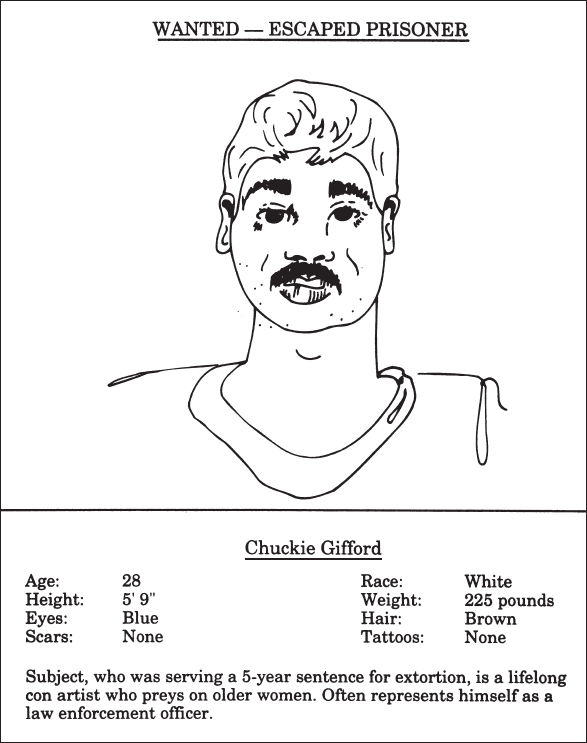
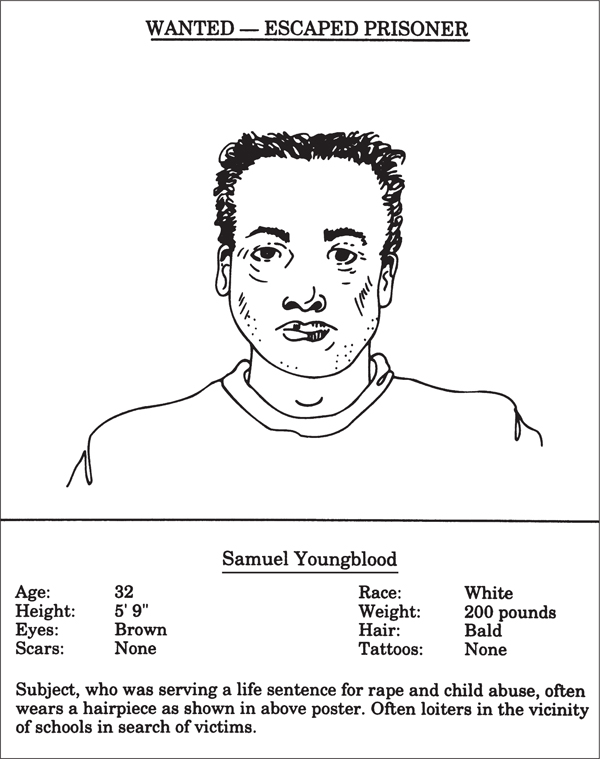
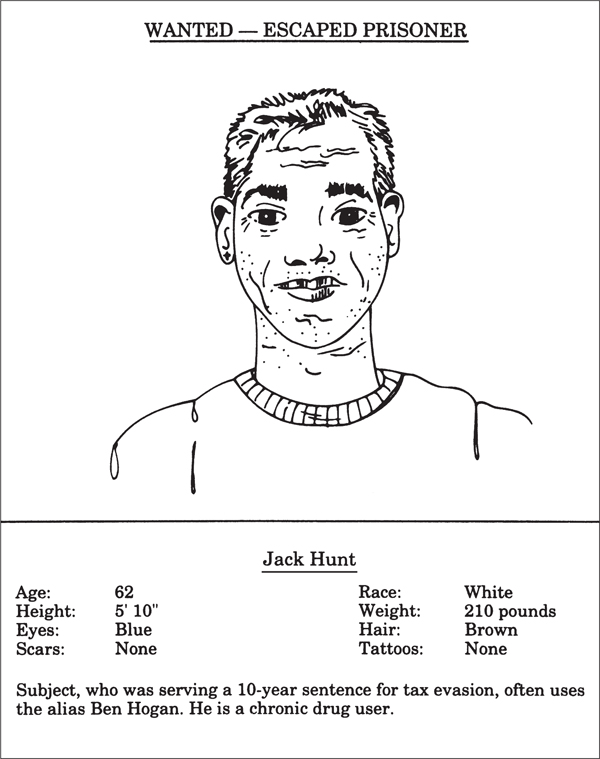
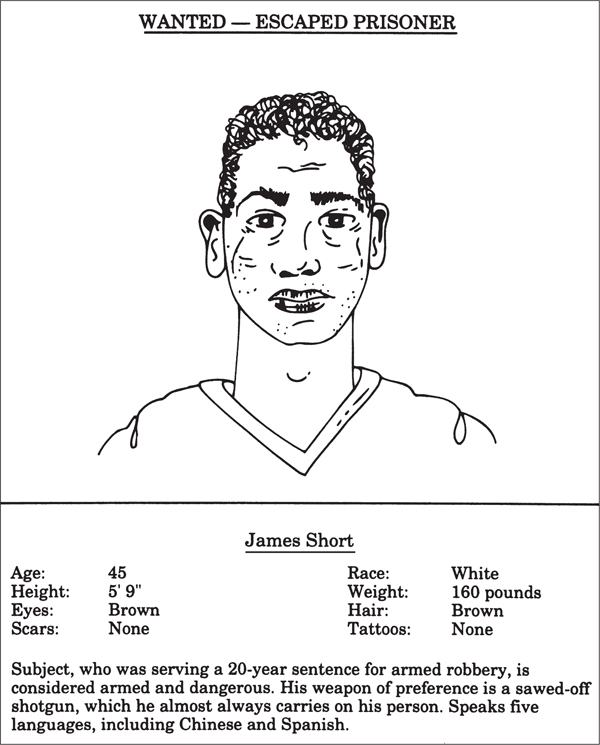
DO NOT PROCEED UNTIL 5 MINUTES HAVE ELAPSED
Directions: Answer questions 116–120 solely on the basis of the wanted posters on the preceding pages. Do NOT refer back to the posters when answering these questions.
116.Which of the escaped inmates illustrated in the following posters often loiters in the vicinity of schools?
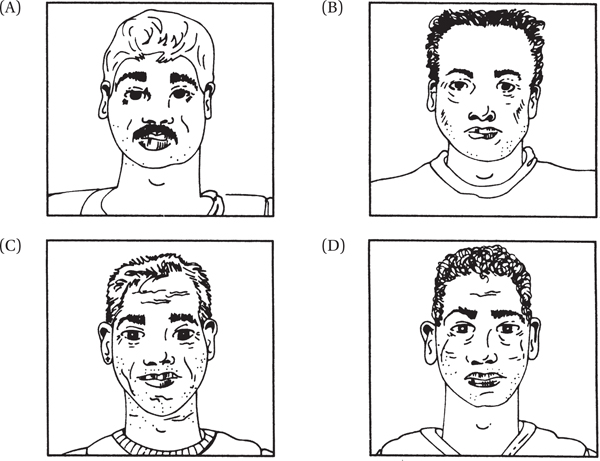
117.Which of the escaped inmates illustrated in the following posters often carries a sawed-off shotgun?
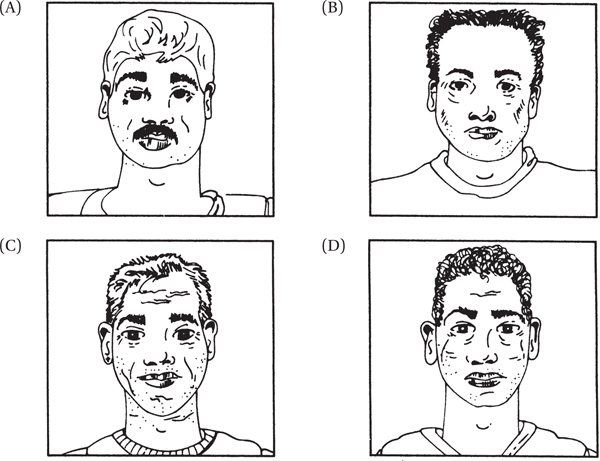
118.Which of the escaped inmates illustrated in the following posters uses the alias Ben Hogan?
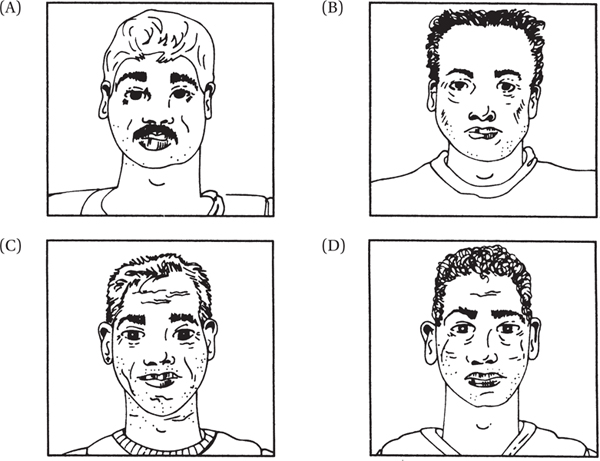
119.Which of the escaped inmates illustrated in the following posters often wears a hairpiece?
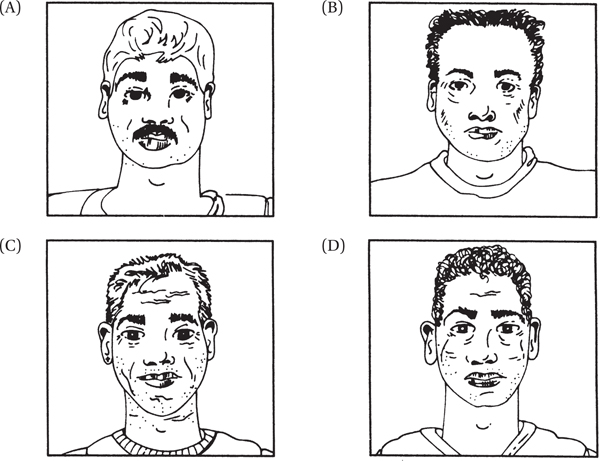
120.Which of the escaped inmates illustrated in the following posters was serving a life sentence when he escaped?
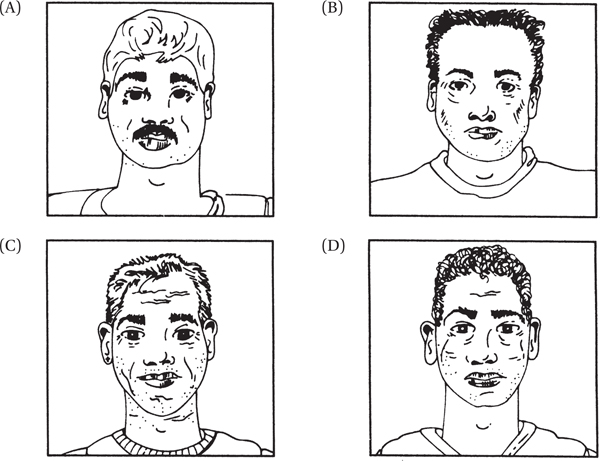
Insert the number of correct answers you obtained in the blank space for each section of the examination. The scale in the next column indicates how you did. The information at the bottom indicates how to correct your weaknesses.
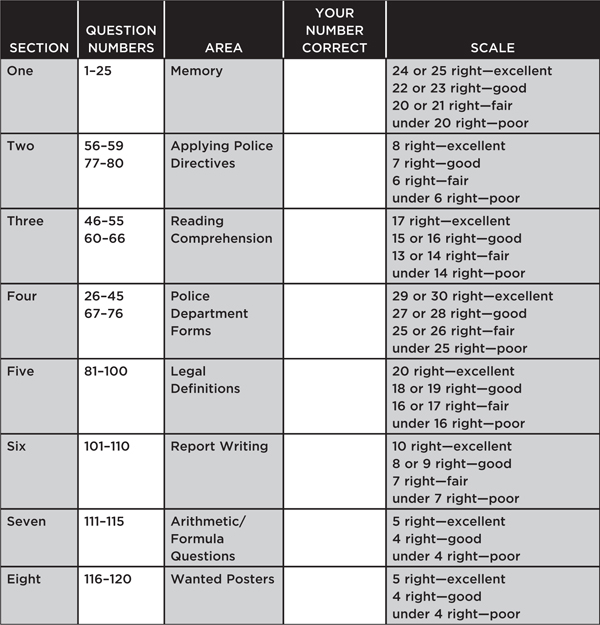
1.If you are weak in Section One, then concentrate on Chapters 2 and 3.
2.If you are weak in Section Two, then concentrate on Chapter 4.
3.If you are weak in Section Three, then concentrate on Chapter 1.
4.If you are weak in Section Four, then concentrate on Chapter 6.
5.If you are weak in Section Five, then concentrate on Chapter 5.
6.If you are weak in Section Six, then concentrate on Chapter 8.
7.If you are weak in Section Seven, then concentrate on Chapter 6.
8.If you are weak in Section Eight, then concentrate on Chapter 6.
Note: Consider yourself weak in a section if you receive other than an excellent rating in it.